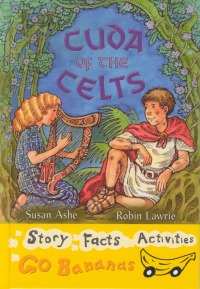| ________________
CM . . .
. Volume XII Number 16 . . . .April 14, 2006 
 |
Cuda of the Celts. (Yellow Go Bananas).
Susan Ashe. Illustrated by Robin Lawrie.
St. Catharines, ON: Crabtree, 2006.
48 pp., pbk. & cl., $7.16 (pbk.), $18.36 (RLB).
ISBN 0-7787-2742-4 (pbk.), ISBN 0-7787-2720-3 (RLB
Subject Headings:
Readers (Primary).
Readers-Romans-Great Britain.
Grades 3-5 / Ages 8-10.
Review by Jennifer Caldwell.
*** /4 |
| |
|

excerpt:
Cuda could hardly believe her eyes when they arrived at the procurator's villa. It was like a palace. Pictures of Roman gods and goddesses, flowers, and animals were painted on the walls. More pictures, made out of tiny pieces of colored stone, covered the floors. Cuda was taken to a room with marble benches, where some women slaves scrubbed her and made her get into a huge trough of water. Then they dressed her in a long Roman tunic.
A slave, who had once been a Celtic warrior, came in. "Tonight you are to play and sing for the procurator," he told Cuda. "Take this lyre and make sure you perform well. Your life may depend on it."
In Cuda of the Celts, author Ashe and illustrator Lawrie together weave a warp of exciting storyline with weft of historical details, delivered in a richly illustrated book.
Young Cuda lives with her father and their tribe during the Roman conquest of Britain (around 43 A.D.). The story begins the night before the men leave for a battle against the Romans. Cuda's father, Bran, is the tribe's bard, and he has taught Cuda to play the harp and sing.
The women and children do all the work on the farm in the men's absence. The victorious Celts return, and, after a night of celebration, they leave for another battle. Cuda discovers Marcus, an injured Roman boy, hiding nearby. She binds his wound, helps hide him, and brings him food even though she knows that her tribe would kill him if they found him.
Another girl from the tribe sees Cuda talking to Marcus, and she tells the tribe. Marcus runs away before the angry tribespeople arrive. Cuda lies and says she was talking to a spirit. Months later, word reaches the tribe that their fighters have all been killed or enslaved and the Romans are sacking the neighbouring village. Cuda tries to hide, but centurions discover her and chain her and other children to be sold as slaves.
Marcus and his father, the Lord Procurator, arrive at the slave market at the right moment and save her. Cuda plays the harp and sings for them, and Marcus' father decides to free her from slavery and bring her up as Marcus's sister. Cuda lives much more luxuriously than in her previous farm life, but she still misses her father and the tribe.
One day, she and Marcus spot Bran, who is now a slave, in a quarry. Marcus tells his father, and at Marcus' birthday party, the newly freed Bran walks in and performs a song about the peace that Marcus and Cuda bring to the warring Romans and Celts with their friendship.
The “Yellow Go Bananas” series is meant to help children in grades 3 and 4 jump from picture books to chapter books. The watercolour and coloured line illustrations are integral to the book, add detail, and enhance the mood of the story.
The book is engaging and fairly fast-paced, with good foreshadowing. The plot is generally believable, but there are some astonishing coincidences, like Marcus's arrival in the marketplace and Cuda's sighting of Bran in the quarry. The conclusion is unsatisfying, as, although presumably everyone lives happily ever after, it was not convincing.
One of the true strengths of this book is its attention to detail. The Celts wear woad designs and torques, use geese to patrol their farmyard, and the men come home from fighting with battle stains. The illustrations give young readers additional information to compare and contrast the Celts and the Romans: hairstyles, clothing, food, architecture, weapons, organization (soldiers in rows, Celtic fighters ranging over a hill), and other aspects of the characters' lives that are not discussed explicitly in the text.
Another strength of the story is the author's age-appropriate inclusion of harsh topics from the time period. While young readers will skim over these, caught up in the action of the story, older readers will note some serious themes. Bran and Cuda discuss whether he killed Roman children during battle, and, later in the story, Celtic children are enslaved and sold at market. Celtic holidays and rituals are introduced (including animal sacrifice), and women's and girls' roles in Celtic society are explored. Throughout the story, the concept of loyalty to tribe and friends is a major theme, and it would make for interesting discussion.
Recommended.
Jennifer Caldwell, a librarian at Richmond Public Library, B.C., chaired the Fiction Selection Committee for the 2005-6 Red Cedar Award.

To comment
on this title or this review, send mail to cm@umanitoba.ca.
Copyright © the Manitoba Library Association. Reproduction for personal
use is permitted only if this copyright notice is maintained. Any
other reproduction is prohibited without permission.
NEXT REVIEW |
TABLE OF CONTENTS FOR THIS ISSUE
- April 14, 2006.
AUTHORS |
TITLES |
MEDIA REVIEWS |
PROFILES |
BACK ISSUES |
SEARCH |
CMARCHIVE |
HOME |
